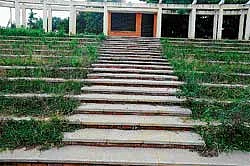
The project, conceived in 2001 when S M Krishna was the chief minister, took a definite shape in 2003 at Mallathahalli facing the ring road side of the Jnanabharathi campus. It could have by now turned into an art lovers’ hub and an attractive tourist centre had the government worked on it, keeping a deadline.
Deccan Herald revisited the project when apprehensions are being raised over the State government’s ability to manage the Tataguni estate on Kanakapura Road. While the Kalagrama project is confined to about 10 acres, Tataguni estate is spread over 468 acres and the government is expected to develop it into an art museum.
Government not bothered
The State government hasn’t even bothered to ink an agreement with Bangalore University for the 20 acres of land it has handed over to the Department of Kannada and Culture for the Kalagrama project in February 2001.
The then Union minister Ananth Kumar Kumar, who facilitated the land arrangement, also backed the setting up of the Indira Gandhi Kala Kendra in about 10 acres on the 20 acres allotted for Kalagrama. The land saga wouldn’t end just yet.
When K C Ramamurthy was the registrar of the varsity (January 28, 2001 to September 5, 2003), he had reservations about the “sub-letting” of Kalagrama land to the Indira Gandhi centre.
In March 2009, the chief secretary advised the government to set aside three acres of land for the National School of Drama out of the 20 acres. In all, only nine acres are left for the Kalagrama project, with three acres going to the NSD and one acre to the Lalit Kala and Natak Academy.
After much deliberation, the government issued an order on July 16, 2009, but it stated that the Indira Gandhi centre would set aside one acre of land for the Academy and nothing specific was mentioned about the land being allocated to the NSD project.
After nearly three years, the government issued yet another order on June 22, 2011, allocating three acres to NSD.
No agreement
But till date, no agreement has been signed between the State government and Bangalore University on the land deal. None of the senior officers has taken the project forward, according to sources in the Kannada and Culture Department.
The Kalagrama project, which dragged at an excruciatingly slow pace, saw the then minister of Kannada and Culture, Rani Satish, inaugurate four ‘kuteeras’ in 2004. In 2008, the Kuvempu Bhasha Bharati was thrown open.
Today, the Public Works Department that is constructing structures at the art centre, is scrambling to complete the “mammoth” Suvarna Samskruthika Bhavan, which it claims will be completed in another “month’s time”.
There is hardly any sign of activity on the premises. There is no proper compound; a security guard had hanged himself from a tree two months ago, and the open air auditorium is outgrown by weeds.
But Kannada and Culture Commissioner Manu Baligar insists that the scheduled works are progressing at a good pace.
“A lot of activities are taking place at Kalagrama contrary to the common belief. It will soon be a thriving place for artists from across the globe. As for the weeds at the auditorium, we haven’t consciously removed them because it creates a natural ambience for artists,” says Baligar.
Non-starters
* Administrative block (710 sq mt): This structure is being built on the lines of ‘Ain houses’ of Madikeri. The building, being constructed at a cost of Rs 1 crore, will have an office, reception, information centre and auditorium. The project awarded to P Vijaya Kumar will be started soon.
* Handicrafts exhibition and sales centre: The objective of this building, which will be built in the Chalukyan style with red-tiled roofs, is to house temporary exhibitions of paintings, sculptures and art works. Book exhibitions, painting, dance and theatre competitions, and other cultural programmes will be conducted here.
* Shilpakala Kuteeras: For providing space for exhibitions and accommodation for sculptors. Art works like terracotta, cane work, carpentry, metal craft, screen painting, fibre-glass carving and sculptures will be exhibited. The chief architect, PWD, has sent the blueprint to the Department of Kannada and Culture for approval, after which estimates will be prepared. (Only structures have come up)
* Exhibition complex for various arts (1,000 sq mt): The building, which will be built in the style of the Moodabidri temple in Dakshina Kannada district, will serve as a practice room and dormitory. It will have a dining room and five cottages.
